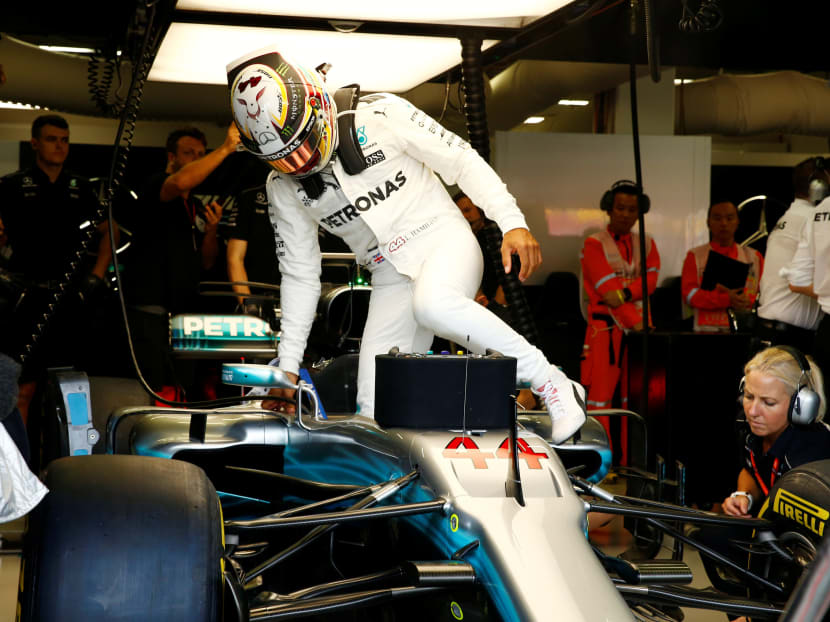Effective data usage drives Mercedes to the top in F1
SINGAPORE – In a fast-paced sport like Formula One (F1), where cars can travel at top speeds of over 370kmh, every second counts, as it can be the difference between victory and finishing outside the podium.

Mercedes' Lewis Hamilton stepping in to his car during practice during the recent Singapore Grand Prix weekend. Photo: REUTERS
SINGAPORE – In a fast-paced sport like Formula One (F1), where cars can travel at top speeds of over 370kmh, every second counts, as it can be the difference between victory and finishing outside the podium.
While the abilities of the drivers do have an impact on the results of a race, it is often the team with the best strategy and ability to fully optimise their car’s performance on the various tracks that proves decisive.
It is why over the past few years, F1 teams have begun to place more emphasis on the gathering and effective usage of big data in their continuous quest to emerge top of an increasingly competitive field.
One of the leaders in this area is the Mercedes-AMG Petronas Motorsport team, which has won both the constructors and drivers championships over the last three years.
Each of the Mercedes race cars – driven by Lewis Hamilton and Valtteri Bottas – are outfitted with 200 physical data sensors which capture millions of data points – which equates to about 400GB of data – every race weekend.
Based on the data gathered, the Mercedes team are then better able to make strategic decisions to help them gain an edge over their rivals in the next race.
Said Mercedes’ head of IT Matt Harris during a recent media tour of the Mercedes-AMG Petronas Motorsport Garage at the F1 Pit Building just days before the Singapore Grand Prix: “If you go back 10 years or so, we as a team created as much data in a whole season as we now do in one race weekend.
“We need more data for the car to run better, whether in terms of reliability or performance. But with changes in the ECU (Electronic Control Unit) and the ability to store more data on the car and get data off the car quicker, we will be able to give our engineers more finite information to make decisions.”
One way Mercedes has managed to optimise their use of data has been through their multi-year partnership with specialist flash-memory data storage provider Pure Storage, which began last year.
Through the partnership with Pure, Mercedes has been able to decrease the space required to store data in their garage on race days by 68 per cent, which has seen them save close to £100,000 (S$182,650) in operating costs annually.
In addition, using Pure’s FlashArray technology, it now takes 70 percent less time for the Mercedes team to extract information – where it took about seven minutes to extract data previously, it now only requires about two and a half minutes.
“For us, (data) storage is now no longer something that needs a huge amount of resource to manage and look after,” said Harris. “It is much simpler, we’ve been able to save a lot of money and resources which we can then divert towards developing other aspects of our car.
“It went from taking about seven minutes to open data, down to just over two minutes. When you’re watching the car runs over the weekend, it takes about one minute for the car to turn around between runs. In that time, you need to make a decision, but if it takes you five and a half minutes to get the data, how can you make the right one on time?
“So cutting down the time it takes to extract data has helped us improve our performance.”
However, Harris also highlighted that while the gathering of data is a vital area, it is also important that the team is able to correctly analyse it.
“You can have all the data in the world, but if you’re looking at the wrong piece of it, you’re not going to make the right decisions,” explained Harris.
“Generally, you ignore the normal data…you don’t need to have clever people looking at the boring, mundane, repetitive things.
“You should get their brains working on the new things, looking at the exceptional data that comes up, or different patterns that could mean a previously unidentified problem with the car, or provide a way to help improve the systems moving forward.
“But it needs fast access to data – which Pure provides – and it needs tools that are capable of filtering out that norm and giving you those exceptions, especially when you’re looking at the raw data.
“All this adds up, and goes a long way to ensure that we remain ahead of the competition.”
For the record, Hamilton and Bottas finished first and third respectively in the Singapore night race after a crash at the start of the race wiped out Ferrari’s Sebastian Vettel, who started the race in pole position, and teammate Kimi Raikkonen as well as red Bull’s Max Verstappen.
With six races to go, three-time F1 champion Hamilton, who started the Singapore race a mere three points ahead Vettel, now has a healthy 28-point lead over his closest rival.





